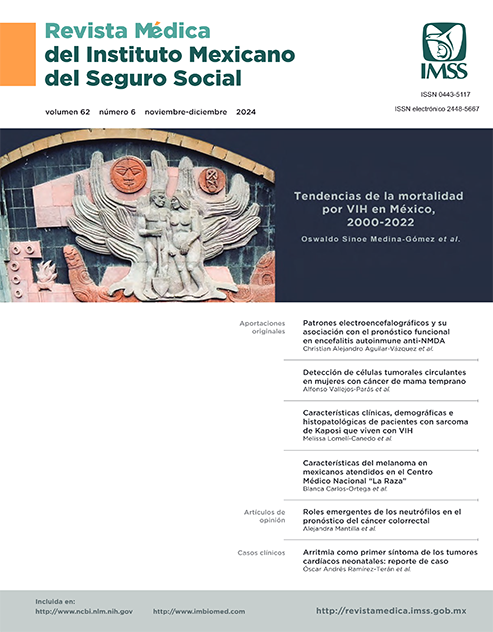Roles emergentes de los neutrófilos en el pronóstico del cáncer colorrectal
##plugins.themes.themeEleven.article.main##
Palabras clave
Biomarcadores de Tumor, Neoplasias del Colon, Neutrófilos, Fenotipo, Microambiente Tumoral / Biomarkers, Tumor, Colonic Neoplasms, Neutrophils, Phenotype, Tumor Microenvironmen
Resumen
El cáncer colorrectal (CCR) es uno de los más frecuentes y letales en México y el mundo. Es de resaltar que, a nivel global, la incidencia del CCR aumenta a razón del 2% anual en pacientes menores de 50 años. Su detección temprana, basada principalmente en la colonoscopia a partir de los 45 años, es una de las armas más importantes en la clínica para disminuir su mortalidad. Cuando la neoplasia está presente, la piedra angular en el tratamiento es la cirugía, sin embargo, factores pronósticos señalados en los reportes de patología y la investigación biomédica del microambiente tumoral pueden ofrecer nuevos parámetros que sirvan como biomarcadores de pronóstico y predicción. En este sentido, señalar la presencia o ausencia de células de la respuesta inmune comienza a dar indicios de su relevancia pronóstica. Si bien este campo es aún controversial, nuestras evidencias recientes indican que la presencia de neutrófilos con un fenotipo antitumoral, particularmente en el margen invasivo de tumores del colon, podría ser un indicativo de buen pronóstico. Esta información emergente sugiere que la descripción de las características de las células de la respuesta inmune, en particular la de los neutrófilos, podría contribuir a evaluar la evolución del CCR y a identificar a los pacientes con mayor riesgo de recurrencias. En este artículo, discutimos algunos puntos relevantes que deben ser abordados al momento de la interpretación de la información relacionada con los neutrófilos en el contexto del CCR.
Referencias
World Health Organzation. Global Cancer Observatory. Lyon, France: WHO; 2020. Disponible en: https://gco.iarc.fr/
Siegel RL, Wagle NS, Cercek A, et al. Colorectal cancer statistics, 2023. CA Cancer J Clin. 2023;73(3):233-254. doi: 10.3322/ CAAC.21772.
Quail DF, Amulic B, Aziz M, et al. Neutrophil phenotypes and functions in cancer: A consensus statement. J Exp Med. 2022; 219(6). doi: 10.1084/JEM.20220011.
Vadillo E, Mantilla A, Aguilar-Flores C, et al. The invasive margin of early-stage human colon tumors is infiltrated with neutrophils of an antitumoral phenotype. J Leukoc Biol. 2023. doi: 10.1093/JLEUKO/QIAD123.
Schnoor M, Vadillo E, Guerrero-Fonseca IM. The extravasation cascade revisited from a neutrophil perspctive. Curr Opin Physiol. 2021;19:119-128. doi: 10.1016/J.COPHYS.2020.09.014.
Vadillo E. Leukocyte movement during immune responses. Cell Mov Heal Dis. 2022;177-191. doi: 10.1016/B978 -0-323-90195-6.00003-6.
Guerrero-Fonseca IM, García-Ponce A, Vadillo E, et al. HS1 deficiency protects against sepsis by attenuating neutrophil-inflicted lung damage. Eur J Cell Biol. 2022;101(2). doi: 10.1016/J. EJCB.2022.151214.
Bui TM, Yalom LK, Sumagin R. Tumor-associated neutrophils: orchestrating cancer pathobiology and therapeutic resistance. Expert Opin Ther Targets. 2021;25(7):573-583. doi: 10.1080/14728222.2021.1954162.
Ohms M, Möller S, Laskay T. An Attempt to Polarize Human Neutrophils Toward N1 and N2 Phenotypes in vitro. Front Immunol. 2020;11. doi: 10.3389/FIMMU.2020.00532.
Shaul ME, Fridlender ZG. The dual role of neutrophils in cancer. Semin Immunol. 2021;101582. doi: 10.1016/J.SMIM. 2021.101582.
Yamamoto H, Watanabe Y, Arai H, et al. Microsatellite instability: A 2024 update. Cancer Sci. 2024. doi: 10.1111/CAS.16160.
Jesinghaus M, Schmitt M, Lang C, et al. Morphology Matters: A Critical Reappraisal of the Clinical Relevance of Morphologic Criteria From the 2019 WHO Classification in a Large Colorectal Cancer Cohort Comprising 1004 Cases. Am J Surg Pathol. 2021;45(7):969-978. doi: 10.1097/PAS.0000000000001692.
Cupp MA, Cariolou M, Tzoulaki I, et al. Neutrophil to lymphocyte ratio and cancer prognosis: an umbrella review of systematic reviews and meta-analyses of observational studies. BMC Med. 2020;18(1). doi: 10.1186/S12916-020-01817-1.
Zheng W, Wu J, Peng Y, et al. Tumor-Associated Neutrophils in Colorectal Cancer Development, Progression and Immunotherapy. Cancers. 2022;14(19). doi: 10.3390/cancers14194755.
Jang TJ, Park JB, Lee JI. The Expression of CD10 and CD15 Is Progressively Increased during Colorectal Cancer Development. Korean J Pathol. 2013;47(4):340-347. doi: 10.4132/ KOREANJPATHOL.2013.47.4.340.
Su H, Cai T, Zhang S, et al. Identification of hub genes associated with neutrophils infiltration in colorectal cancer. J Cell Mol Med. 2021;25(7):3371-3380. doi: 10.1111/JCMM.16414.
Zhu B, Luo J, Jiang Y, et al. Prognostic significance of no mograms integrating IL-37 expression, neutrophil level, and MMR status in patients with colorectal cancer. Cancer Med. 2018;7(8):3682-3694. doi: 10.1002/CAM4.1663.
Rottmann BG, Patel N, Ahmed M, et al. Clinicopathological significance of neutrophil-rich colorectal carcinoma. J Clin Pathol. 2023;76(1):34-39. doi: 10.1136/JCLINPATH-2021-207702.
Weng M, Yue Y, Wu D, et al. Increased MPO in Colorectal Cancer Is Associated With High Peripheral Neutrophil Counts and a Poor Prognosis: A TCGA With Propensity Score-Matched Analysis. Front Oncol. 2022;12. doi: 10.3389/FONC.2022.940706.
Chen S, Zhang Q, Lu L, et al. Heterogeneity of neutrophils in cancer: one size does not fit all. Cancer Biol Med. 2022;19(12):1629. doi: 10.20892/J.ISSN.2095-3941.2022.0426.
Väyrynen JP, Haruki K, Väyrynen SA, et al. Prognostic significance of myeloid immune cells and their spatial distribution in the colorectal cancer microenvironment. J Immunother Cancer. 2021;9(4). doi: 10.1136/jitc-2020-002297.
Roncucci L, Mora E, Mariani F, et al. Myeloperoxidase-positive cell infiltration in colorectal carcinogenesis as indicator of colorectal cancer risk. Cancer Epidemiol Biomarkers Prev. 2008;17(9):2291-2297. doi: 10.1158/1055-9965.EPI-08-0224.
Guidoboni M, Gafà R, Viel A, et al. Microsatellite instability and high content of activated cytotoxic lymphocytes identify colon cancer patients with a favorable prognosis. Am J Pathol. 2001;159(1):297-304. doi: 10.1016/S0002-9440(10)61695-1.
Chengzeng YIN, Okugawa Y, Yamamoto A, et al. Prognostic significance of CD8+ tumor-infiltrating lymphocytes and CD66b+ tumor-associated neutrophils in the invasive margins of stages I-III colorectal cancer. Oncol Lett. 2022;24(1). doi: 10.3892/OL.2022.13333.
Edin S, Kaprio T, Hagström J, et al. The Prognostic Importance of CD20+ B lymphocytes in Colorectal Cancer and the Relation to Other Immune Cell subsets. Sci Rep. 2019;9(1). doi: 10.1038/S41598-019-56441-8.
Xu X, Ma J, Yu G, et al. Effective Predictor of Colorectal Cancer Survival Based on Exclusive Expression Pattern Among Different Immune Cell Infiltration. J Histochem Cytochem. 2021;69 (4):271-286. doi: 10.1369/0022155421991938.
Laviron M, Petit M, Weber-Delacroix E, et al. Tumor-associated macrophage heterogeneity is driven by tissue territories in breast cancer. Cell Rep. 2022;39(8):110865. doi: 10.1016/J. CELREP.2022.110865.


